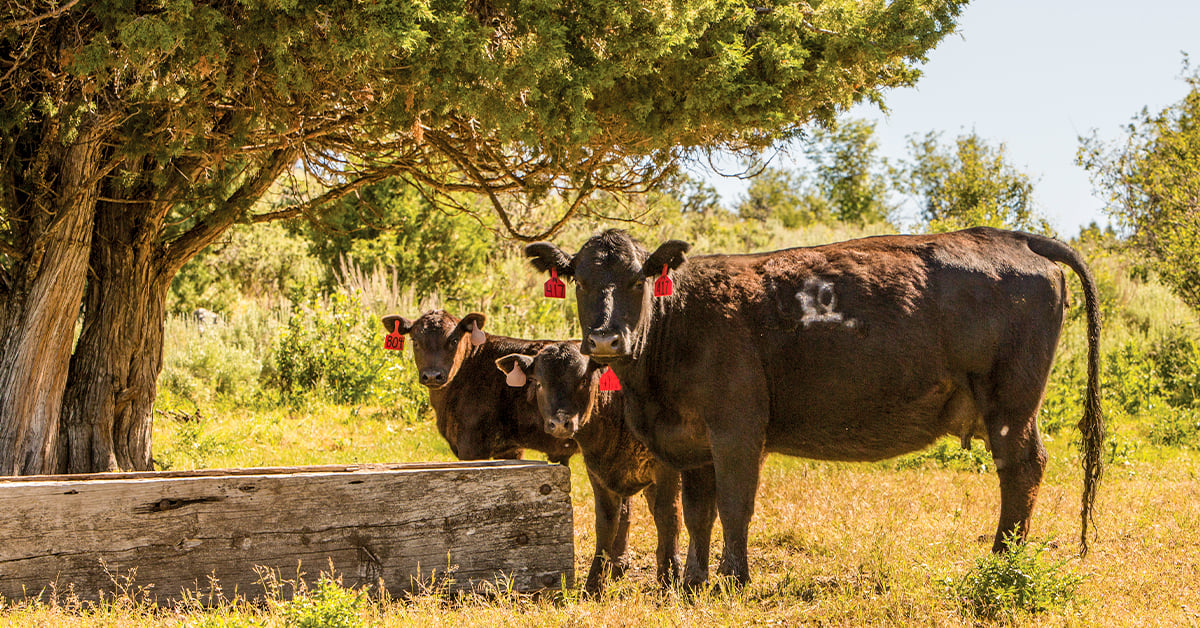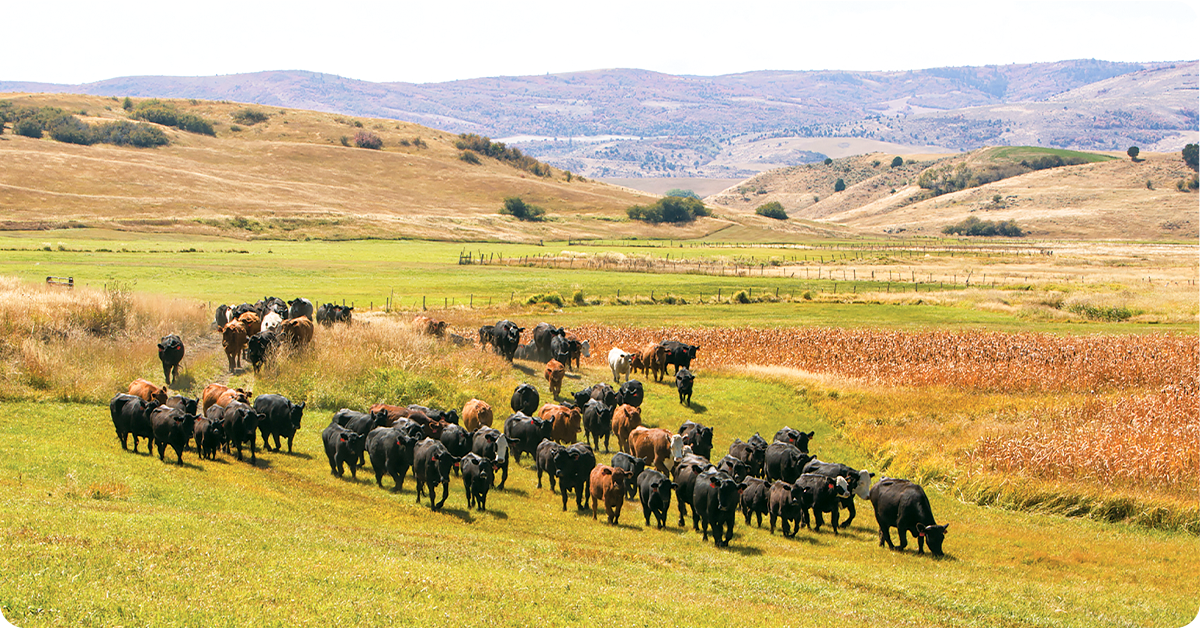
The livelihood of western cattlemen is dependent upon timely, annual precipitation. The cyclic nature of drought events forces western producers to have prepared drought management strategies that will mitigate the effects of drought on overall herd health and production. Currently, western producers that are faced with drought conditions should develop and implement drought management strategies.
Drought can be defined as a prolonged period during which annual precipitation is less than 75% of average. Low annual precipitation, or timing of precipitation, lowers soil moisture condition and its ability to sustain annual plant growth. The key to surviving a drought event is to have a drought management plan. Producers must be proactive, rather than reactive and plan designs should minimize the negative effects of drought.
All basic drought plans must keep in mind two fundamental objectives:
- Minimize damage to rangeland resources during and after drought
- Minimize economic loss
Trying to maintain whole herd production during a drought using supplements and purchased feeds often isn’t practical. One must employ sound strategies to reduce forage demand on drought stressed resources. Drought management plans should develop key trigger events, such as measured soil moisture levels or measured annual precipitation. These measurements will allow one to gauge current drought conditions. Measured trigger events must occur prior to the active forage growing season, which will allow time to implement effective drought management strategies. Effective drought strategies must keep in mind three key components:
- Livestock Inventory
- Use of existing forage resources
- Resource Availability
- Forest and BLM allotments – will they allow you to turnout
- Prior year residual forage
- Anticipated forage growth
- Alternative feeding programs
- Leased pasture
Adjusting Livestock Inventory
Herd animals must be closely evaluated to determine potential animals that could be culled. Having a herd depopulation plan allows one to manage a productive core herd through a drought period. If a herd depopulation plan needs to be implemented, consider the following:
- Only take cow/calf pairs to grass
- Non-pregnant cows or cows that lost their calves, should be culled. Therefore, only cows that have the potential to wean a calf are turned out to pasture.
- Cull cows that have been identified as poor mothers, have unsound udders, feet or leg issues, bad disposition and other physical problems.
- Closely evaluate cows based on production history. Use at least two years of individual cow records to identify cows that have consistently weaned calves that rank in the bottom 10 – 25% of your herd.
- Check cows for pregnancy as soon after the breeding season. Experienced ultrasound technicians are close to 100% accurate on a 30 to 35-day old fetus. Individuals experienced in rectal palpation can detect pregnancy in cows where the fetus is between 45 and 60-days. Accuracy is critical as you do not want to sell a pregnant cow.
- Critically evaluate your heifer replacement program. Although these heifers require less total feed, compared to older cows, they do need higher-quality feed because they are still growing. If severe drought persists across the growing season, on-farm or off-farm hay production can be reduced. This will limit supply and typically result in higher purchased feed costs.
- If you have females and plan on culling them after weaning their calf, these can be culled early to help reduce forage demand for the core herd.
- Consider culling older bulls immediately after the breeding season.
- Delaying the decision to reduce cattle inventory may accelerate financial losses.
During drought events, take advantage of early weaning programs. For every 2.5 days a calf is weaned, the forage saved is equivalent to one dry cow day. Weaning calves at 45 to 60 days of age is a sound management strategy and should be included on your overall drought management plan. Weaning calves at three to five months of age may also be a viable alternative if available forage becomes limiting in the latter part of the grazing season.

Management of Existing Forages
Understanding annual forage production under limited precipitation is critical. A drought management plan should ensure minimal impact to the rangeland resources. Carrying capacity should be adjusted and based on the amount of residual forage and anticipated current year’s growth. In the west, limited precipitation during the months of March through May will reduce annual forage production. Limit turn out numbers by employing culling techniques outlined in this article. Work closely with your IFA beef consultant to determine limiting nutrients and only supplement to maintain performance of your core herd. Aside from culling and weaning techniques, consider some additional options to extend the grazing season:
- Delay turn-out. Utilize carryover hay for the core herd.
- Split large pastures with temporary cross-fences. This will concentrate cattle and allow better utilization of existing forage.
- Do not be tempted to overgraze existing pastures. Recovery will be slow and subsequent annual forage production will be reduced for several years.
- Sound record keeping relative to forage production and grazing management is an important aspect of good ranch management.
Alternative Feeding Programs
Care must be taken when considering an alternative feeding program. These decisions must be based on production goals such as re-breeding cows, maintaining calving interval, and optimizing pounds of calf weaned per cow. All alternative feeding programs must minimize feed cost per pound of calf sold. Trying to maintain whole herd production during a drought using supplements often isn’t practical. Options to consider when examining alternative feeding programs:
- Cost of alternative forage availability and or purchased hay.
- Fully utilize local feeds to keep transportation costs down.
- Supplements should be used to offset deficiency of purchased low-quality feeds.
- Analyze forages prior to purchase.
- Utilize feed by-products and in emergency situations, substitute 1 pound of grain or concentrate feed for 2 pounds of alfalfa hay or 3 pounds of grass hay.
- Balance every ration against the animal’s requirements.
- Feed losses can be costly. Pay close attention to feed losses and change feed management to reduce those losses.
- Separate core herd by stage of production (age, lactation, early pregnancy, dry, and late pregnancy). Feed highest quality feeds to animals with the highest requirement.
- Lower quality feeds can be fed to cows during early to mid-pregnancy.
Preparation is Key
Drought events are cyclic in nature and livestock producers must have an active drought management plan. Effective plans should mitigate droughts' negative effects and ensure minimal damage to rangeland resources and minimal economic losses. Attempts to maintain whole herd inventory during a drought event by purchasing feeds might not be practical.
Producers must employ sound strategies to reduce forage demand on drought stressed resources. Key trigger events, such as measured soil moisture levels or measured annual precipitation will allow one to gauge current drought conditions. Measured trigger events must occur prior to the active forage growing season, which will allow time to implement effective drought management strategies.
Here to Help
Effective drought strategies must evaluate current livestock inventory, existing forage resources, and alternative feeding programs. Our IFA teams are here to help you navigate the potential drought season. Contact your local IFA Nutritionist or Sales Consultant to learn more about drought management strategies and asses your options
Discover IFA Feed & Nutrition Services
Written by Jim Lamb, PhD, PAS, IFA Feed and Nutrition and originally published in the IFA Cooperator magazine (vol. 88, no. 2) Summer 2022.

